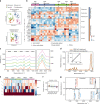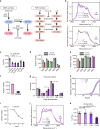Raman-guided subcellular pharmaco-metabolomics for metastatic melanoma cells
- PMID: 32973134
- PMCID: PMC7518429
- DOI: 10.1038/s41467-020-18376-x
Raman-guided subcellular pharmaco-metabolomics for metastatic melanoma cells
Abstract
Non-invasively probing metabolites within single live cells is highly desired but challenging. Here we utilize Raman spectro-microscopy for spatial mapping of metabolites within single cells, with the specific goal of identifying druggable metabolic susceptibilities from a series of patient-derived melanoma cell lines. Each cell line represents a different characteristic level of cancer cell de-differentiation. First, with Raman spectroscopy, followed by stimulated Raman scattering (SRS) microscopy and transcriptomics analysis, we identify the fatty acid synthesis pathway as a druggable susceptibility for differentiated melanocytic cells. We then utilize hyperspectral-SRS imaging of intracellular lipid droplets to identify a previously unknown susceptibility of lipid mono-unsaturation within de-differentiated mesenchymal cells with innate resistance to BRAF inhibition. Drugging this target leads to cellular apoptosis accompanied by the formation of phase-separated intracellular membrane domains. The integration of subcellular Raman spectro-microscopy with lipidomics and transcriptomics suggests possible lipid regulatory mechanisms underlying this pharmacological treatment. Our method should provide a general approach in spatially-resolved single cell metabolomics studies.
Conflict of interest statement
The authors declare no competing interests.
Figures







Similar articles
-
Spectral fingerprinting of cellular lipid droplets using stimulated Raman scattering microscopy and chemometric analysis.Analyst. 2024 Jan 15;149(2):553-562. doi: 10.1039/d3an01684f. Analyst. 2024. PMID: 38088863
-
Imaging of lipids in microalgae with coherent anti-stokes Raman scattering microscopy.Plant Physiol. 2015 Mar;167(3):603-16. doi: 10.1104/pp.114.252197. Epub 2015 Jan 12. Plant Physiol. 2015. PMID: 25583924 Free PMC article.
-
Noninvasive imaging of intracellular lipid metabolism in macrophages by Raman microscopy in combination with stable isotopic labeling.Anal Chem. 2012 Oct 16;84(20):8549-56. doi: 10.1021/ac3012347. Epub 2012 Oct 2. Anal Chem. 2012. PMID: 22954250
-
Applications of coherent Raman scattering microscopies to clinical and biological studies.Analyst. 2015 Jun 21;140(12):3897-909. doi: 10.1039/c5an00178a. Epub 2015 Mar 26. Analyst. 2015. PMID: 25811305 Review.
-
New insights into lipid and fatty acid metabolism from Raman spectroscopy.Analyst. 2024 Sep 23;149(19):4789-4810. doi: 10.1039/d4an00846d. Analyst. 2024. PMID: 39258960 Review.
Cited by
-
Fused Raman spectroscopic analysis of blood and saliva delivers high accuracy for head and neck cancer diagnostics.Sci Rep. 2022 Nov 2;12(1):18464. doi: 10.1038/s41598-022-22197-x. Sci Rep. 2022. PMID: 36323705 Free PMC article.
-
Identification of pathogens and detection of antibiotic susceptibility at single-cell resolution by Raman spectroscopy combined with machine learning.Front Microbiol. 2023 Jan 4;13:1076965. doi: 10.3389/fmicb.2022.1076965. eCollection 2022. Front Microbiol. 2023. PMID: 36687641 Free PMC article.
-
The role of altered lipid composition and distribution in liver fibrosis revealed by multimodal nonlinear optical microscopy.Sci Adv. 2023 Jan 13;9(2):eabq2937. doi: 10.1126/sciadv.abq2937. Epub 2023 Jan 13. Sci Adv. 2023. PMID: 36638165 Free PMC article.
-
Miniaturized Chemical Tags for Optical Imaging.Angew Chem Int Ed Engl. 2022 Aug 22;61(34):e202204788. doi: 10.1002/anie.202204788. Epub 2022 Jul 21. Angew Chem Int Ed Engl. 2022. PMID: 35704518 Free PMC article. Review.
-
Bringing Vibrational Imaging to Chemical Biology with Molecular Probes.ACS Chem Biol. 2022 Jul 15;17(7):1621-1637. doi: 10.1021/acschembio.2c00200. Epub 2022 Jun 30. ACS Chem Biol. 2022. PMID: 35772040 Free PMC article.
References
Publication types
MeSH terms
Substances
Grants and funding
LinkOut - more resources
Full Text Sources
Other Literature Sources
Medical
Research Materials

